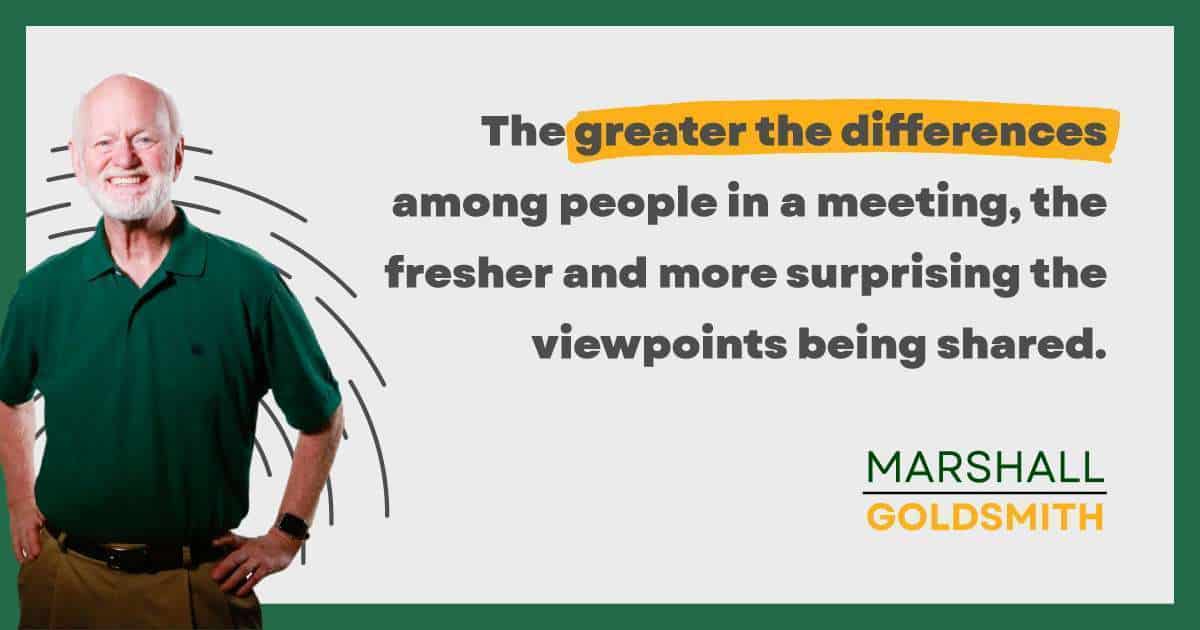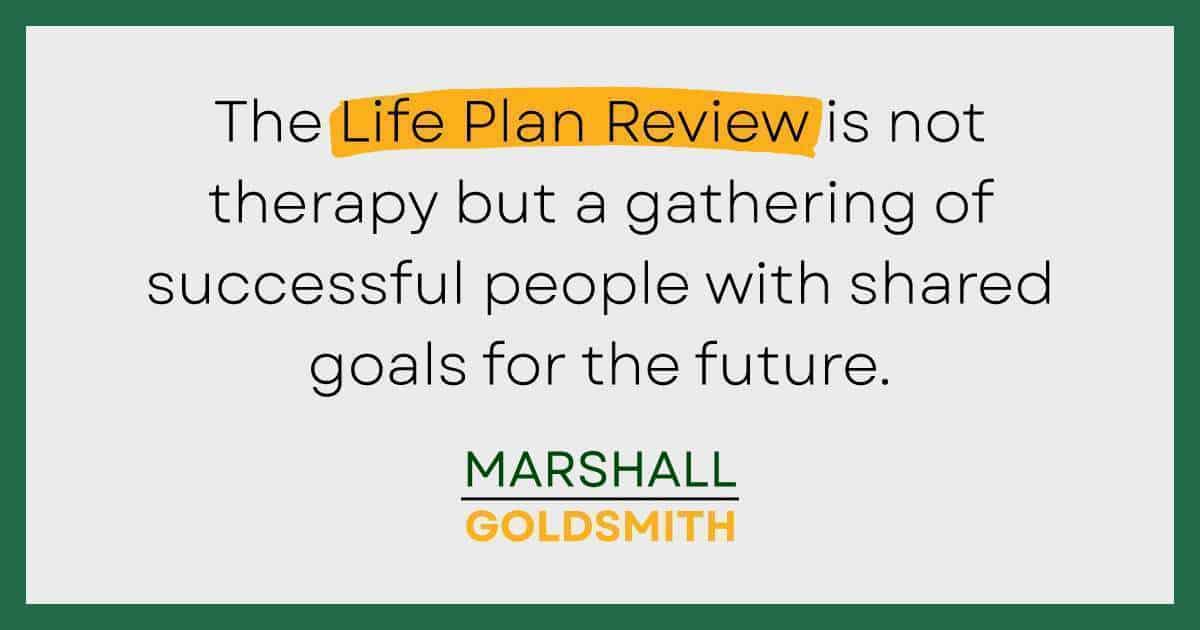Playing Favorites By Marshall Goldsmith There’s a reason I devote...
I created the Life Plan Review (LPR) with Alan Mulally, the ex-chairman of Ford, loosely based on his Business Plan review, which he instituted at Ford and used as a way to help turn that company around back in the 1970s.
The LPR is designed to close the gap between what you plan to do in your life and what you actually get done. It consists of four steps — weekly meetings where you answer fixed questions with a partner to improve your life, self-monitoring between weekly meetings, a weekly plan review based on its relevance and your personal need, and the importance of not doing it alone.
The pandemic changed things as the in-person LPR was set to launch. I managed to create a version of it online, via Zoom, and it proved that this community can thrive even virtually.
We made the structure of the LPR as simple as possible, because simple self-monitoring structures are easier to follow and are less likely to be abandoned midstream. You rate your effort on six or more goals of your choosing every day, then report your scoring average on each question in a weekly group setting. How hard can that be?
Pre-2020 I would have said that the sociability requirement— that people who don’t work together have to meet in person at the same time every week—represented the most challenging feature of the LPR. How do you get busy people to show up each week? But the COVID pandemic and videoconferencing apps such as Zoom have taken care of that problem. We’ve all grown accustomed to seeing one another’s faces on screens rather than in person.
Still, as any successful leader knows, the fate of any team begins and ends with personnel selection. How do you cast the characters in your LPR group for maximum appeal so that members want to come back each week? Zoom alone doesn’t solve that eternal riddle. You need a strategy to create a group that shows up each week and loves it.
I learned from the success of my annual “What’s Next” sessions that it was important to aim for maximum diversity.
Start with an equitable gender split. Then mix and match people according to age, culture, nationality, professional rank, and line of work. Do not presume that radically different people might not mix well or be interested in one another. Successful people are innately curious. Diversity should be highlighted, not modulated. That’s the point of diversity: The greater the differences among people in a meeting, the fresher and more surprising the viewpoints being shared.

When I chose the 50 people for the first 10-week LPR experiment, I modeled myself on Noah filling his ark, with two of each species at most. A typical session had Jan Carlson, the CEO of Europe’s largest manufacturer of seat belts and other auto-safety systems, calling in from Stockholm; Gail Miller, a grandmother leading a sprawling family business in Utah; Nankhonde van den Broek, a 39-year-old nonprofit professional in Zambia taking over her late father’s business; Pau Gasol, the 39-year-old NBA star at the end of his career; Dr. Jim Downing, a surgeon running St. Jude Children’s Research Hospital in Memphis; Margo Georgiadis, the CEO of Ancestry in Boston, who was in the process of working herself out of the job by selling Ancestry to a private equity group; and Marguerite Mariscal, the 31-year-old CEO helping David Chang reorganize his restaurant empire.
You might not seat these seven people at the same wedding table, but in a weekly group meeting where everyone shared the same self-improvement objectives, the chemistry was palpable. Diversity does that.
Group size is more a function of bringing in the right people and leaving out the wrong people. If you have any doubt that a possible choice will add value to the group, don’t ignore your concerns simply to fill out the group to achieve your idea of a proper head count. Better to leave out a candidate than to allow him or her to kill the group’s vibe. I’d recommend a group of no fewer than five people, no more than eight. And don’t let the meeting run longer than 90 minutes.
The LPR is not therapy. It’s a gathering of successful people with shared goals for the future, not a gripe session for unsuccessful people with problems. And by “successful” I don’t mean people measured solely by their impressive status, power, and paycheck. You’re looking for people of any and every stripe who share the same optimism about getting better. They are not victims or martyrs. Do that, and you’ll always have a roomful of equals where no one is too intimidated to speak up or too self-satisfied to listen.
Someone has to lead the group. If the LPR group was your idea, then you’re responsible for running the meeting, preferably with a light touch rather than a heavy fist. Otherwise, your LPR can become, as a fellow coach put it, “over-structured and under-facilitated.” In the same way that Alan Mulally was always the facilitator of his BPR meetings at Boeing and Ford (because it was his idea), my partner Mark Thompson and I were the facilitators in our LPRs. It’s more an administrative task—calling on people, moving things along, enforcing the “no judgment” rule, maintaining the safe space environment—than a coaching role.
Until the group learns to be self-governing, assume that everyone is looking to you to keep the train running on time.

Adding Too Much Value Won’t Get You There By Marshall...
C-Suite Master Class: No, But, However By Marshall Goldsmith Continuing...
The Doerr Institute: Expanding the Market for Coaches By Marshall...
Making Leadership Development Part of the College Degree at Rice...
Sanyin Siang – Winner of the Thinkers50 Marshall Goldsmith Coaching...
Thinkers50 Marshall Goldsmith Distinguished Achievement Award in Coaching – Nominees...
Leading with Influence: What Is Influence360°? By Marshall Goldsmith Founder...
Are You a Dominator, Manipulator, Persuader or Influencer? By Marshall...
Leading with Influence: Redefining Modern Influence Part 2 By Marshall...
My mission is simple. I want to help successful people achieve positive, lasting change and behavior; for themselves, their people, and their teams. I want to help you make your life a little better. With four decades of experience helping top CEOs and executives overcome limiting beliefs and behaviors to achieve greater success, I don’t do this for fame and accolades. I do this because I love helping people!
As an executive educator and coach, I help people understand how our beliefs and the environments we operate in can trigger negative behaviors. Through simple and practical advice, I help people achieve and sustain positive behavioral change.